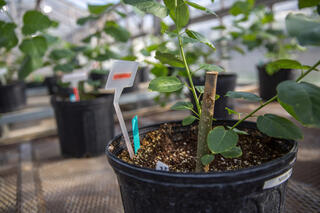Engineered poplar lignin has more of valuable “clip-off” chemical

Scientists have introduced a bacterial enzyme into bioenergy poplars to increase the amount of a valuable platform chemical.
The Science
Lignin is the complex polymer that gives plants their structural integrity also makes them difficult to break down. This complexity also affords opportunities to make a diverse array of biochemicals and bioproducts from components in lignin. Building blocks that are present in small amounts in the lignin of the bioenergy crop poplar are valuable platform chemicals that are easy to “clip-off” during plant deconstruction. Scientists at the Great Lakes Bioenergy Research Center engineered a new type of poplar with more of this valuable chemical and less lignin overall, resulting in wood that is easier to deconstruct and more valuable.
The Impact
Lignin is difficult to break down and chemically complex. Although those attributes are a major challenge for industrial biomass processing, they also open the door for creating important and valuable biochemicals and bioproducts from lignin. This research demonstrates a new way to engineer the lignin in bioenergy crops that makes it easier to break down. This new method also changes the composition of lignin so that it includes more of a valuable building block that can be upgraded to valuable biochemicals and bioproducts. These changes could make the production of biofuels and bioproducts easier and cheaper.
Summary
The plasticity of lignin synthesis allows scientists to engineer lignin polymers that have added value and are easier to break down. Up to 10% of poplar lignin is naturally comprised of p-hydroxybenzoate (pHB). This group is attached to the lignin polymer by weak ester linkages (relative to ether linkages that abound in lignin), making it easy to “clip-off” in biomass deconstruction. Once pHB is separated from biomass, it is both a valuable platform chemical and can be upgraded to other biochemicals and bioproducts. The pathway by which pHB is synthesized in plants has not been fully elucidated. However, by expressing bacterial chorismite pyruvate lyase (CPL) in plastids, plants have been shown to produce more pHB. In this study, GLBRC scientists produced transgenic hybrid poplar lines to express bacterial CPL, which resulted in a 50% increase of stable pHB in mature trees and 10 times more in developing trees compared to control trees. This work demonstrates how engineering bioenergy crops can improve the efficiency and value of industrial biomass deconstruction by increasing the amount of easily cleavable and valuable chemical groups.
Contact
Shawn D. Mansfield
Professor of Wood Science, University of British Columbia
shawn.mansfield@ubc.ca, 604-822-0196
Funding
This work was supported by the Great Lakes Bioenergy Research Center, U.S. Department of Energy, Office of Science, Office of Biological and Environmental Research under award DE-SC0018409.
Publication
Mottiar, Y., Karlen, S.D., Goacher, R.E., Ralph, J. and Mansfield, S.D., “Metabolic engineering of p-hydroxybenzoate in poplar lignin.” Plant Biotechnology Journal. (2022) [DOI: 10.1111/pbi.13935]
Related Links
https://onlinelibrary.wiley.com/doi/epdf/10.1111/pbi.13935